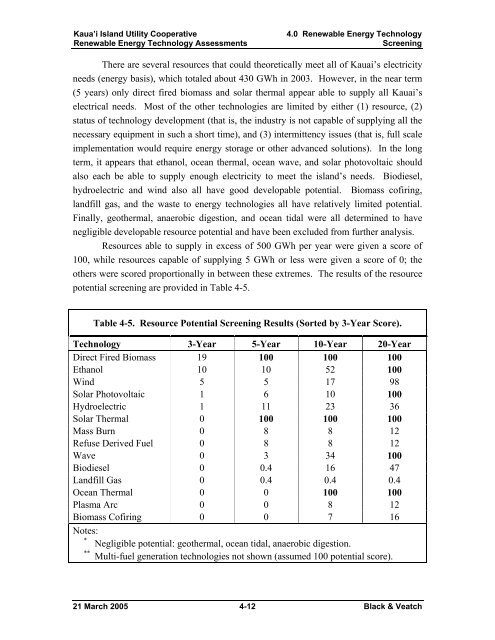Renewable Energy Technology Assessments - Kauai Island Utility ...
Renewable Energy Technology Assessments - Kauai Island Utility ...
Renewable Energy Technology Assessments - Kauai Island Utility ...
You also want an ePaper? Increase the reach of your titles
YUMPU automatically turns print PDFs into web optimized ePapers that Google loves.
Kaua’i <strong>Island</strong> <strong>Utility</strong> Cooperative<br />
<strong>Renewable</strong> <strong>Energy</strong> <strong>Technology</strong> <strong>Assessments</strong><br />
4.0 <strong>Renewable</strong> <strong>Energy</strong> <strong>Technology</strong><br />
Screening<br />
There are several resources that could theoretically meet all of <strong>Kauai</strong>’s electricity<br />
needs (energy basis), which totaled about 430 GWh in 2003. However, in the near term<br />
(5 years) only direct fired biomass and solar thermal appear able to supply all <strong>Kauai</strong>’s<br />
electrical needs. Most of the other technologies are limited by either (1) resource, (2)<br />
status of technology development (that is, the industry is not capable of supplying all the<br />
necessary equipment in such a short time), and (3) intermittency issues (that is, full scale<br />
implementation would require energy storage or other advanced solutions). In the long<br />
term, it appears that ethanol, ocean thermal, ocean wave, and solar photovoltaic should<br />
also each be able to supply enough electricity to meet the island’s needs. Biodiesel,<br />
hydroelectric and wind also all have good developable potential. Biomass cofiring,<br />
landfill gas, and the waste to energy technologies all have relatively limited potential.<br />
Finally, geothermal, anaerobic digestion, and ocean tidal were all determined to have<br />
negligible developable resource potential and have been excluded from further analysis.<br />
Resources able to supply in excess of 500 GWh per year were given a score of<br />
100, while resources capable of supplying 5 GWh or less were given a score of 0; the<br />
others were scored proportionally in between these extremes. The results of the resource<br />
potential screening are provided in Table 4-5.<br />
Table 4-5. Resource Potential Screening Results (Sorted by 3-Year Score).<br />
<strong>Technology</strong> 3-Year 5-Year 10-Year 20-Year<br />
Direct Fired Biomass 19 100 100 100<br />
Ethanol 10 10 52 100<br />
Wind 5 5 17 98<br />
Solar Photovoltaic 1 6 10 100<br />
Hydroelectric 1 11 23 36<br />
Solar Thermal 0 100 100 100<br />
Mass Burn 0 8 8 12<br />
Refuse Derived Fuel 0 8 8 12<br />
Wave 0 3 34 100<br />
Biodiesel 0 0.4 16 47<br />
Landfill Gas 0 0.4 0.4 0.4<br />
Ocean Thermal 0 0 100 100<br />
Plasma Arc 0 0 8 12<br />
Biomass Cofiring 0 0 7 16<br />
Notes:<br />
* Negligible potential: geothermal, ocean tidal, anaerobic digestion.<br />
** Multi-fuel generation technologies not shown (assumed 100 potential score).<br />
21 March 2005 4-12 Black & Veatch
















